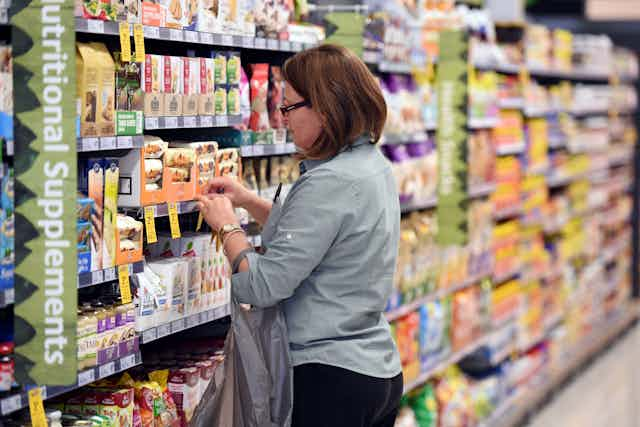If you’re raising $45 billion then that is effectively saying to every Australian household: you’re going to pay $4,500 more tax every year. – Shadow Assistant Treasurer Andrew Leigh, speaking with journalist Alison Carabine on RN Breakfast, December 9, 2015.
GST reform is again front and centre of the tax policy debate, with state and federal leaders discussing the issue at the Council of Australian Governments (COAG) meeting in Sydney this week.
Is Labor’s shadow assistant treasurer, Andrew Leigh, right to warn that each Australian household may face the prospect of paying an extra A$4,500 a year in GST?
Checking the source
A spokeswoman for Leigh told The Conversation that the figure of A$45 billion was taken from a Fairfax news report on a leaked COAG document that details federal Treasury modelling prepared in July.
According to the Fairfax report, the modelling outlined various GST options, including:
The fourth and most radical option would be to raise the GST to 15%, expanding it to include food and non-alcoholic drinks, water and sewerage. This would raise $45 billion annually.
Leigh’s spokesman said dividing $45 billion by the roughly 10 million households we have in Australia gets you an average of $4,500 per household.
Leigh’s statement begins with an “if”, which is an acknowledgement that the $45 billion option is just one of many options on the table.
But the key phrase in the Fairfax report Leigh is referencing is “most radical option”. The scenario he warns of is at the extreme end of the scenarios that Treasury modelled.
Perspective, please
Leigh’s comment about the $45 billion option does reflect recent news reports on leaked Treasury modelling. However, his phrasing would leave most people with the impression that the GST burden could be divided equally across all households. That impression is misleading.
A bit of perspective is required.
Firstly, GST reform will affect households differently, based on the consumption patterns of different household types.
Like Treasury, the Parliamentary Budget Office (PBO) recently mapped out a range of GST reform scenarios, detailed in the table below.
The PBO’s Scenario Four would boost the GST rate to 15% and extend it to basic food, water and sewerage – this would raise $42.1 billion. The PBO’s most extreme option, Scenario Five, would also include health, education and child care and would raise $49.3 billion in net additional GST revenue.

The PBO modelling shows (in table 4-12) that wealthy people (who spend more) will pay more GST overall than poorer people. Under the PBO’s Scenario Four, households in the top 10% for income could expect to face an increase of tax in absolute terms that is three times higher than for households in the bottom decile.

So Leigh’s approach of averaging the $45 billion out across all households – as though we all buy the same amount of goods and services – is not very reflective of reality.
Secondly, remember that his warning reflects the most radical of the scenarios modelled by Treasury.
The GST proposals modelled by Treasury include increases in the rate of the GST to 12.5% or 15%; and/or broadening the base of the GST to include food, water, sewerage, health, education and/or financial services. The funds raised by the various models range from $15 billion to $45 billion.
The third thing to bear in mind is compensation.
Leigh’s statement was not about people’s net position, it was about how much tax people paid and he made no direct comment on compensation. But when you hear about GST reform, remember it remains unclear what level of compensation will be built into any policy to raise the GST.
The Grattan Institute has modelled the compensation that would be required as part of GST reform. The institute presented a model that would ensure that on average households with incomes of less than $100,000 would be no worse off.
The matter of compensation is unresolved, with contradictory statements from the prime minister and treasurer.
Of course, it’s theoretically possible that there will be no compensation for low-income people as part of a plan to boost the GST rate, but Prime Minister Malcolm Turnbull has described that as “inconceivable”.
Verdict
Andrew Leigh’s phrasing would leave most people with the impression that the GST burden could be divided equally across all households. That impression is misleading.
The statement by the shadow assistant treasurer reflects the “worst” of the scenarios presented by Treasury modelling. Even if no compensation is paid, the increase in the GST paid by low-income households is lower than the GST increase on the expenditure of high-income earners. –Helen Hodgson
Review
I agree with this analysis.
As discussed in the article, the Treasury and PBO modelling discusses a range of possible scenarios in relation to increasing the GST, and the one mentioned by Andrew Leigh is one of the more extreme proposals.
While this scenario is a possibility, implying that the increased GST revenue would be raised equally across all households is incorrect. Any proposal to increase the GST without compensation for lower-income households would be unlikely to be politically acceptable.
Further, as highlighted in the article, even if no compensation was offered, the amount of additional GST paid would vary between households depending on their level of expenditure. In actual dollar terms, higher-income households would have a greater increase in the amount of GST paid than lower-income households. –Kathrin Bain
Update: At 2:55 PM AEST on December 13, 2015 the following sentences were added to this article: “Leigh’s statement was not about people’s net position, it was about how much tax people paid and he made no direct comment on compensation. But when you hear about GST reform, remember it remains unclear what level of compensation will be built into any policy to raise the GST” and “Leigh’s statement begins with an ‘if’, which is an acknowledgement that the $45 billion option is just one of many options on the table.”

